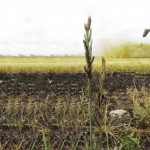According to the 2013 producer harvest samples collected and analyzed by the Grain Research Lab (GRL) at the Canadian Grain Commission, 18 per cent of Canadian Western Red Spring wheat samples and 10.7 per cent of the Canadian Western Amber durum samples received from across Western Canada by mid-October were downgraded due to ergot. According […] Read more

Ergot on the rise in Western Canada
Ergot levels have been increasing since 2010. Ergot infection could mean downgraded quality or even rejection
Protein lower than last year
Test results from the Canadian Grain Comm-ission’s 2013 Harvest Samples Program are showing a lower average protein content for western Canadian red spring wheat than last year. “This year the quality is the same but the protein is down a little,” says Twylla McKendry, program manager and head of crops section, analytical services for the […] Read more
Bleaching grain
Fall rain can mean bring lower quality wheat and fewer hard vitreous kernels
An untimely rain just before harvest can cause wheat kernels to “bleach” or whiten and can lead to some loss in quality that can cause downgrading at the elevator. Bleaching of grain kernels is caused by wet conditions at or near maturity when alternate wetting and drying causes tiny fissures because the grain expands when […] Read more
Beef producer promotes value of hybrid vigour Part 3 of 3
Don Guilford, who farms near Clearwater in southwest Manitoba, says there is no doubt in his mind that to make ranching sustainable in the future, producers need to plan their herd to meet a specific market. “You need to capture every opportunity,” says Guilford. “You have to think about what breeds you want to produce, […] Read more
Bee kills and seed treatments
Bee deaths are getting a lot of attention. New research shows this mystery could be linked to seed treatments
After Ontario recorded 240 bee kills last year, involving 40 different beekeepers, it’s no surprise that the issue of bee deaths has been front and centre in the media or that there is confusion about the various research reports that have been unearthed. Shrinking numbers of honey bees across Europe and North America has prompted […] Read moreSoil testing with the PRS probe
Western Ag Labs’ Plant Root Simulator Probe offers farmers a unique way to look at crop nutrient needs
Every soil testing lab has its own methodology for testing soil and making nutrient recommendations. Since the 1990s, Western Ag Labs Ltd. of Saskatoon has been using its own unique tool — the Plant Root Simulator — to analyze soil and make recommendations for its clients. There are two steps to Western Ag Labs’ process. […] Read more
Glume blotch or fusarium?
Glume blotch is a cereal disease that thrives in wet, humid growing conditions. It has generally been more prevalent in Ontario, but it does occur across the Prairies. Glume blotch symptoms on harvested grain can be confused with the fusarium damaged kernels (FDK) caused by fusarium head blight, and can negatively affect the quality of grain, especially […] Read more
Don’t let cows plan their grazing
Cows are very poor managers of grass. So if all you are doing is opening the gate and turning them out to graze for the summer, they won’t make the best use of land resources and achieve the productivity derived from a pre-planned grazing system, says Blain Hjertaas. Hjertaas, a holistic management instructor from Redvers, […] Read more
Aster yellows: hard to pin down
Aster yellows caused significant damage and resulted in heavy yield losses in many canola fields across Western Canada in 2012. With no economic threshold established for the disease, and no known way to effectively control the problem, it’s something that’s hard for farmers to get a handle on. Aster leafhoppers have been arriving in Canada […] Read more
Society needs to value good land stewardship
Proper land management benefits the beef producer, but also produces benefits the public needs to appreciate too
Proper land management benefits the beef producer, but also produces benefits the public needs to appreciate too (EDITORS NOTE: This is part two of a three-part series with three Manitoba beef producers discussing what they consider important to the future viability of their ranches.) It’s high time society prop- erly recognizes the contribu- tion made […] Read more

